by Briscoe White | Feb 22, 2011 | Basics, Gardening, Growing, Herbs, Inspiration, Miscellaneous |
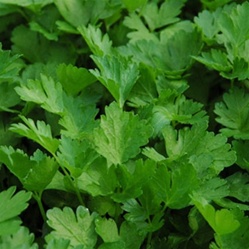
Italian Flat Leaf Parsley
Happy Parsley Day! On February 22nd, we take time to honor a much loved culinary and medicinal herb that packs a punch of flavor! An herb, a spice AND a vegetable all in one plant, this dynamic herb is a key component in many cuisines like Middle Eastern and Spanish, but is most distinctly known in Italian dishes. Parsley symbolizes love, protection and purification and throughout history has been a sign of honor and class. Ancient Greeks used Parsley to honor champions of sporting events, and it was also used in wreaths and sprinkled on the dead. The word “Parsley” is derived from the Greek word meaning “rocks or stones”, which reflects the terrain Parsley is native to. They believed that Parsley grew in the spot where the mythological hero Archemorus was slain.
The two main varieties, Italian Flat Leaf and Curly, are adored for different reasons. While some believe the Flat Leaf is easier to grow, it is the quintessential Parsley for cooking, as it has a more flavorful taste. The soft, crinkled look of the Curly Parsley makes it a great garnish and it is used to enhance many gourmet dishes with its beauty. Also a necessary component to the favorable herbal combination, Bouquet Garni, Parsley tastes terrific with hearty dishes like potatoes, stews, lamb, lasagna or rice.
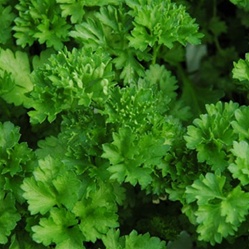
Curly Parsley
Medicinally, Parsley has a long history of being associated with women’s health. An emmenagouge, it was often used to start the menstrual cycle, but should not be consumed in great quantity by pregnant women. Parsley also contains elements that help the body absorb Manganese much more efficiently, an important mineral for strengthening bones. When paired with dishes that contain high zinc or copper-rich foods, it helps retain these bone-improving vitamins and minerals much more thoroughly. When applied directly to insect bites, it is also said to soothe the itching or stinging sensation!
A great companion plant, Parsley attracts insects, diverting their attention from other garden growers. Plant Parsley near your tomatoes to draw the attention of pesky tomato hornworms, moths and flies away from your veggies. Parsley thrives in full sun, with moist, well-drained soil, but because of its tough seed coat, it can often be hard to germinate from seed. If germination actually does occur, it should only take four to six weeks to see sprouts peeking through the soil. Superstition says that the reason that Parsley takes so long to germinate is because it has to travel to Hell and back seven times before sprouting. Though we aren’t sure where this delightful herb got such a bad rap, we assure you, it’s been growing safe and sound in our greenhouse!
by Briscoe White | Feb 18, 2011 | Gardening, Growing, Herbs, Inspiration, Life on the Farm |
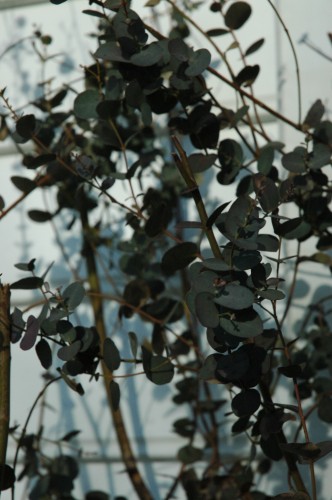
Eucalyptus plants are hardy perennials favored by many gardeners. Our favorite, the Silver Drop variety, has green leaves with a slightly dusty, or silvery, appearance. Their leaves contain highly fragrant oils, used in many medicines and perfumes. Silver Drop sprigs are a perfect addition to floral arrangements, both fresh and dried, because they hold their shape and last a long time without wilting. Considered a valuable everlasting for wreaths, crafts, and dried arrangements, its uniformly rounded leaves, erect, straight stems and elegant silvery color add depth that lasts much longer than most cut foliage.
Native to chillier zones of Tasmania, this beautiful plant is known to be remarkably cold hardy. In the states it thrives in zones 7-11 and even grows marvelously through our hot, humid summers and cold, wet winters here, in the Mid Atlantic. We can personally attest to this– we have one right here on the farm! It is in a pretty exposed area, vulnerable to harsh river winds and hard winter frosts. We’ve even over-pruned in the past few years, and this baby keeps coming back! It’s as beautiful as it is tenacious, and no matter what season, remains our most lovely landscaping shrub. We’re glad it’s here to stay.
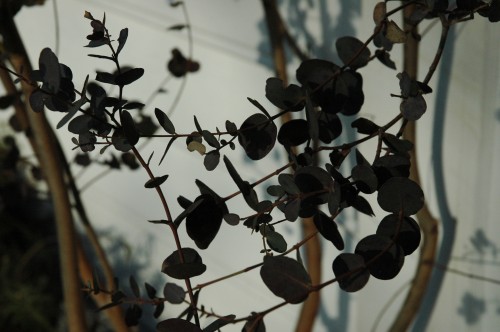
Needless to say, Eucalyptus is pretty easy to grow. Give it lots of sunshine and rich, well-drained soil. Water only when the top inch of soil feels dry to the touch. Prune in the spring, wherever you see any brown or dead foliage. And enjoy!
by Briscoe White | Feb 17, 2011 | Herbs, Life on the Farm, Miscellaneous, Wildlife |
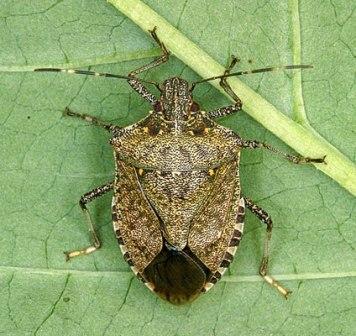
For many of us on the East Coast (particularly MD, DC and VA), this time of year not only marks the first warm weeks which hint of the coming spring season; it means to prepare for the invasion. It’s not a terrorist or nuclear threat we’re talking about…it’s something far smellier: stinkbugs. In 2010 our region suffered a swarm of these foul little pests and as we begin seeing warmer weather in this (hopefully) early spring, they are beginning to settle in like unwanted house guests.
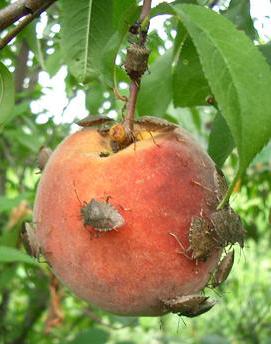
Though they don’t bite or sting, they do emit a pretty putrid odor when crushed, smooshed, vacuumed up, or squished, and though they are more of an annoyance for homeowners, local farmers are beginning to fret. Stinkbugs prey on crops like raspberries, tomatoes, peaches and other fruits, sucking the juices out of them and leaving them undesirable. Especially in the organic farming community, who strive not to use harmful pesticides, concern is on the rise. So, what is your best line of garden defense against these pungent perpetrators? The all natural answer is herbs!
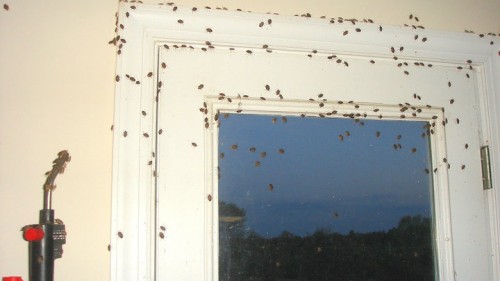
Don't let this happen to your home!
Strongly scented herbs such as Mint, Lavender, Catnip, and Patchouli have been proven to thwart the little stinkers from overwhelming you favorite fruits and veggies. (It’s hard to believe that they are picky about smells…I guess everyone likes their own brand!) You can also try planting other natural insect deterrents around your home or garden like Tansy, ‘Citronella’ Scented Geraniums, Pyrethrums and Rue to keep the bugs at bay. For the insidious insects that have already made it indoors, try making sachets with some of these herbs or use their essential oils to coat your window sills and thresholds. This will hopefully keep the rest of the stinkbugs from sneaking in and joining their friends inside your nice warm home. You can also fill jars with soapy water to catch the critters that have already begun to show up indoors, as the soap will dissolve their exoskeleton, killing them in a non-toxic way.
In conjunction with February being National Bird Feeding Month, try attracting birds to your garden with feeders, houses and baths, to keep your bug problem to a minimum. We’ve heard that blue jays are fond of these stinky little snacks, so encourage them and other seed-eating friends to nest around your yard to prevent the problem from getting out of hand. Bats also find stink bugs to be a delicacy, so place bat boxes throughout your yard and near the garden to help battle the bugs.
by Herb Exchange | Feb 11, 2011 | Gardening, Growing, Herbs, Indoor Gardening, Inspiration, Miscellaneous, Urban Gardening |
Since we recently posted on our Social Media and Marketing Director, Caroline’s Nasturtiums that went to seed, there has been an exciting development! Read her update below for the news…
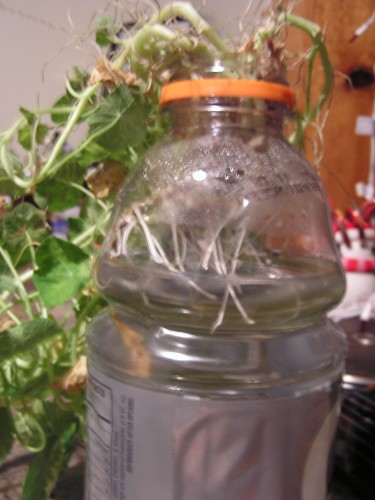
My severed Nasturtium actually started sprouting little, white roots!
Well, when repotting my ‘Alaska Mix’ and ‘Empress of India’ Nasturtiums recently, I accidentally broke off a beautiful, healthy stem that had a ton of marbled foliage trailing from it. Worried that I had just ruined one of the prettiest branches of the plant, I immediately started to look around for a solution. With the speed of an ER nurse, I placed the severed “appendage” in the first thing I could find and fill with water–an empty Gatorade bottle. After filling the bottle with cold water and jamming the wounded end of my favorite plant down into the neck of the bottle so that it was just under the water level, I left my crippled Nasturtium to recuperate in a sunny spot. I had honestly forgotten that it was even there, and figured that maybe it was only staying green because it was freshly cut, and, much like a bouquet of cut flowers, it would wilt and become compost in a week or so. Much to my surprise when I happened to take a look at it last night, the lonely, broken stem had started to put out lots of little, white volunteer roots, each stretching down into the water. Amazed that my accidental pruning had resulted in another Nasturtium plant, I just had to share! The moral of my story is that even trial and error in gardening can grow to be a great experience!
by Briscoe White | Feb 11, 2011 | Containers, Gardening, Growing, Herbs, Indoor Gardening, Life on the Farm, Miscellaneous, Urban Gardening |
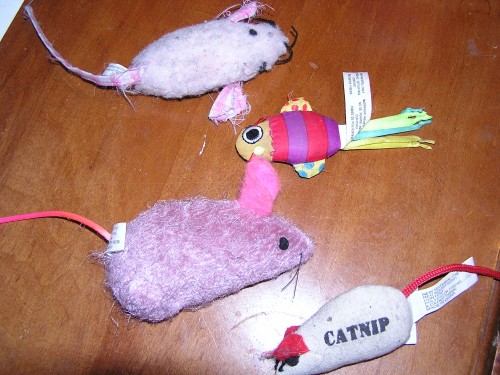
Tons of cat toys are packed with Catnip to perk your cat's interest!
Looking for a great all natural way to treat your favorite feline? Try Catnip! Often found packed into the plush insides of a cute little toy or sold in dried form at local pet stores, catnip makes most cats pretty crazy. Over eighty percent of cats are affected by the chemical component Nepetalactone, which is found in the essential oils of this perennial herb. A combination of genetics and age determine whether your felines will fiend for Catnip, as studies show that kittens don’t seem to respond until around the age of three months. Though not explored extensively, there are many cases of dogs and even some bears who find the scent of “nip” irresistible. Reactions range from sleeping and drooling, to frantically pouncing and running around, and cats seem to also experience heightened tactile sensations which may include being rubbed on their face, petted or brushed to excess.
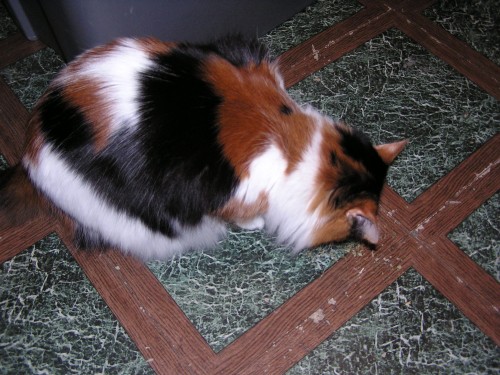
Our Media Director's cat, Sophie, eating dried Catnip. She likes the fresh stuff better!
Also known as an excellent natural insect repellent, the essential oils are often found in many DEET-free bug sprays. If making your own concoction to deter pests, try using Lemon Catnip for a fragrant citrus aroma. Catnip also has a history as a medicinal herb for its sedative properties and makes a soothing tea to help you relax, much like Valerian, an herb known to mellow you out and known commonly as “the poor man’s Valium”. Slightly numbing, Catnip is also reputed to strengthen immunities to fend off colds, fevers and the flu, and also calms an upset stomach. Growing fresh Catnip for your kitties isn’t just fun and games. The vitamins and nutrients they get from eating the raw plant is great for their bodies, and the plant itself can help cause any indigestion which may result from some store-bought foods.
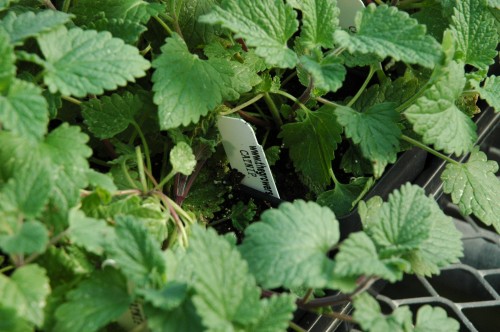
Our Catnip is all natural and because we don't use harsh chemicals, it's purrrrrfectly healthy for your cat!
If you plan to grow Catnip for your cats indoors, you may want to plant two pots, one to keep out of their reach outdoors, and one for them to enjoy inside, but make sure to swap them occasionally so they don’t completely attack the indoor pot! If you’re growing it outdoors, be aware that neighborhood cats may be flocking to your garden. To prevent their frantic frolicking from interfering with other, more tender plants that may be growing nearby, either plant your catnip in a well-drained, separate area of its own, or build a fence around your garden. (If you have problems with container-planted Catnip, try placing it in a large, metal bird cage or dog kennel, where the kitties can’t plow through it all and destroy your plant.) If you want to really encourage your cats to love you more, try planting Catmint, Lemon Catnip and Valerian in your garden. All three of these great herbs are kitty-friendly, human-friendly and make a really calming tea. Treat your cats the natural way and grow them a garden full of treats!
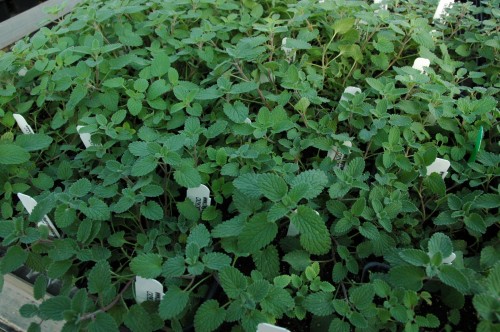
Catmint is another great herb to get your felines frisky!
by Briscoe White | Feb 7, 2011 | Basics, Gardening, Growing, Herbs, Pests and Problems |
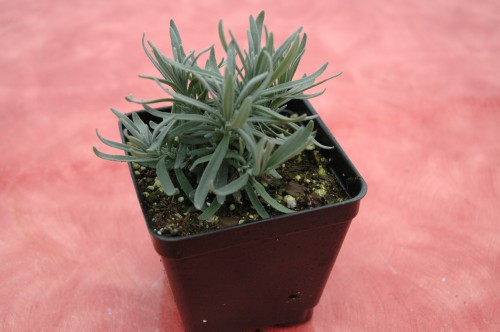
Healthy Lavender
Keeping potted lavender inside for winter can be tricky. They are so touchy about wet feet, they can turn from beautiful to pitiful in a few days. Overcast days with little sun are the perfect breeding ground for all the fungus that prey on lavender plants. Like potting succulents, sand should be added to the potting soil to insure quick drainage.
One sign of trouble is algae growing on the soil surface. This is an indication the soil is too wet for too long. When weather conditions are favorable, fungus will quickly colonize a water logged lavender. To save plants already infected, trim all dead leaves and stems. Clean all debris from the soil surface. Dry the soil quickly, even if you must remove the plant from the pot.
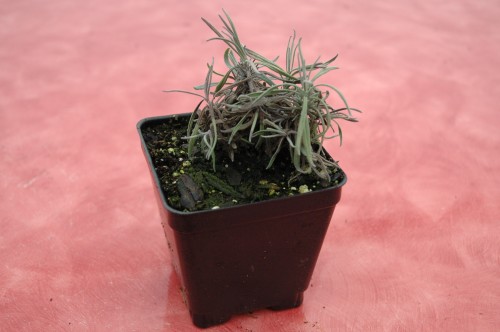
Fungally infected Lavender
There are many fungicides available, some are biological, others chemical. This natural fungicide is safe for kids and pets so if you’re conscious about little fingers or paws playing in the garden, a natural fungicide is often a better choice than a chemical one. In our greenhouse, we treat lavender every week by first spraying a Hydrogen Peroxide disinfectant, then a biological fungicide. Applying chemical fungicides takes less time because it has a residual effect for a week or more, but because we grow mostly herb plants that will be cut and used for culinary purposes, they must be clean and healthy to eat. Though the biological type does not last as long and must be applied more regularly, it’s worth the extra time and effort to ensure that our plants are healthy and treated in an all-natural way.
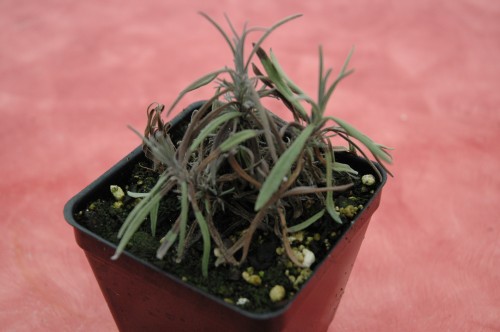
Lavender killed by fungal infection
We prefer to use PlantShield HC Biological Fungicide, which uses an active natural microbe to prevent disease from growing on the root structures and foliage of our plants. We drench the actual soil, rather than the leaves themselves, which allows this natural microbe to saturate the soil and protect the plants from mildew, fungi and other root pathogens. This is just one key step in our promise to ensure healthy, all natural herbs and flowers for our customers. Because of all of the careful nurturing that we employ at The Growers Exchange, we know our plants like the backs of our hands. Staying constantly familiar with our plants allows us to keep a close eye on quality control, and our attention to detail is something we pride ourselves on. Because of this process, we don’t let anything leave our greenhouse that we wouldn’t want to plant in our own garden, so you can be sure that when you order from us, you’re getting only the very best!















